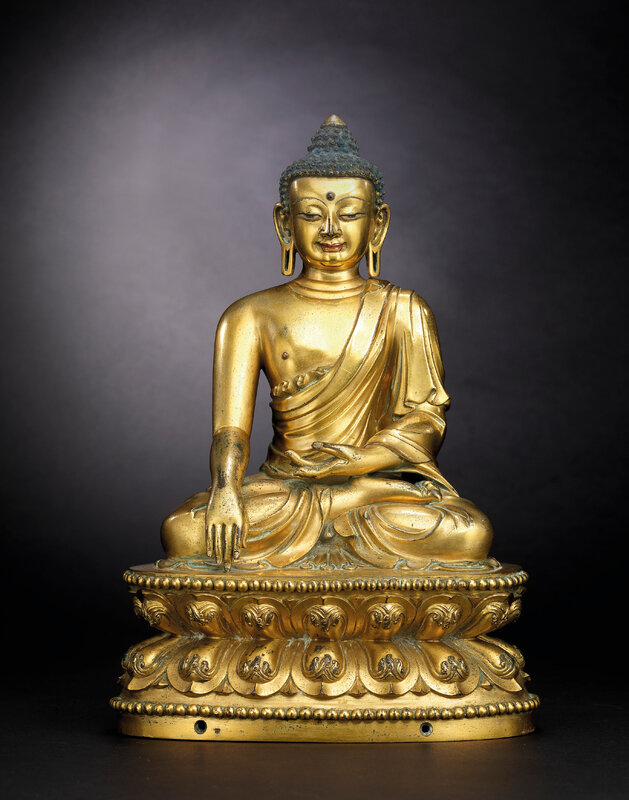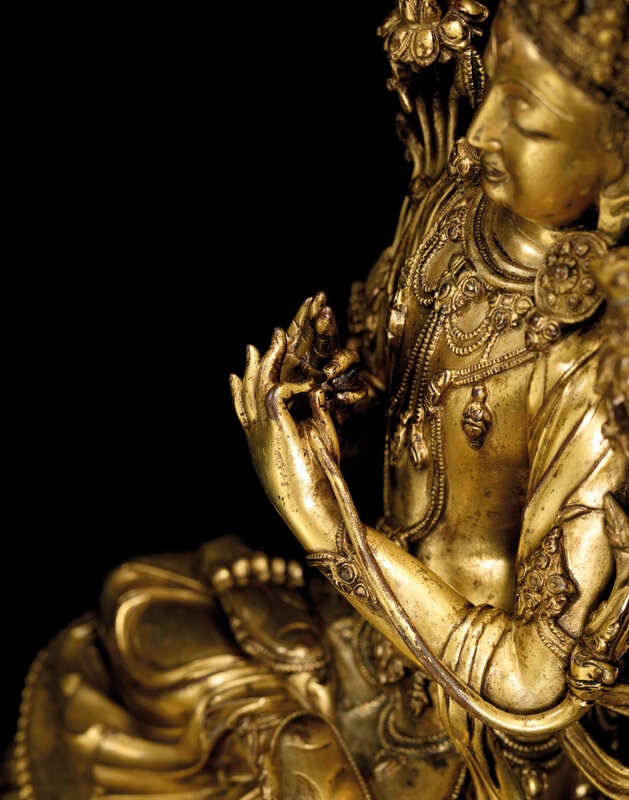A superb gilt-bronze figure of Buddha, Yongle incised six-character presentation mark and of the period (1403-1425)
Lot 3105. A superb gilt-bronze figure of Buddha, Yongle incised six-character presentation mark and of the period (1403-1425); 10 7/8 (27.5 cm.) high. Estimate HKD 12,000,000 - HKD 18,000,000. Price realised HKD 14,440,000. © Christie's Image Ltd 2014.
The figure is finely cast seated in dhyanasana on a double lotus base, the right hand lowered in bhumisparsa mudra and the left hand held above the feet in dhyana mudra, wearing a softly pleated robe draped over the left shoulder and falling in rounded folds on the base. The face is crisply cast with a serene expression with downcast eyes, flanked by long pendulous ears cut with vertical slits, the hair arranged in rows of tight whorls surmounted by a domed usnisa. The lips and eyes are picked out in pigments. The front of the base is incised with six-character Yongle presentation mark, Da Ming Yongle nian shi, 'Bestowed in the Great Ming Yongle period'.
Provenance: Property of a lady, acquired in Australia in the 1980s
Sold at Christie's London, 11 July 2006, lot 96.
Note: The present figure of Buddha is very similar in its modelling to two other well-known, and slightly larger examples, one in the British Museum, illustrated in Arts of Asia, Sep-Oct 1994, vol. 24, p. 84, no. 5, the other formerly in the Speelman Collection, sold at Sotheby's Hong Kong, 7 October 2006, lot 808. Both the British Museum example and the Speelman example are set in elaborate gilt-copper repoussé thrones. It is noted that the base plates of both these Buddhas were held in place by a number of relatively modern screws which were placed through the original holes of the base of the figure beneath the lower row of pearls. Pins set through these holes and into the wooden construction inside the cavity would have held the plate in place. The pins, which would have been visible from the outside after the consecration process, are in fact hidden when the figure is inserted into the throne up to the level of the lower row of pearls. Presumably because of the weight and contents of the statue after consecration, this method of sealing was used over the one normally seen, which requires only a number of cuts in the base rim that catch the plate and secure it.
Christie's. Important Chinese Ceramics and Works of Art, Hong Kong, 26 November 2014

/https%3A%2F%2Fprofilepics.canalblog.com%2Fprofilepics%2F1%2F0%2F100183.jpg)
/https%3A%2F%2Fstorage.canalblog.com%2F03%2F02%2F119589%2F96711876_o.jpg)
/https%3A%2F%2Fstorage.canalblog.com%2F11%2F31%2F119589%2F94773502_o.jpg)
/https%3A%2F%2Fstorage.canalblog.com%2F20%2F83%2F119589%2F94772815_o.jpg)
/https%3A%2F%2Fstorage.canalblog.com%2F26%2F72%2F119589%2F75604929_o.jpg)
/https%3A%2F%2Fstorage.canalblog.com%2F59%2F60%2F119589%2F26458628_o.jpg)







/image%2F1371349%2F20240417%2Fob_9708e8_telechargement.jpg)
/image%2F1371349%2F20240412%2Fob_032fb1_2024-nyr-22642-0928-000-a-rare-painted.jpg)
/http%3A%2F%2Fstorage.canalblog.com%2F37%2F38%2F119589%2F129773469_o.jpg)
/http%3A%2F%2Fstorage.canalblog.com%2F50%2F43%2F119589%2F129706599_o.jpg)